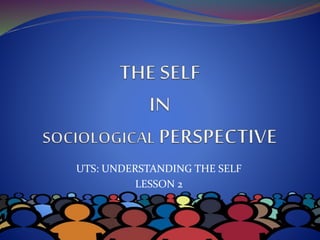
UTS: UNDERSTANDING THE SELF : The self in sociological perspective
- 1. UTS: UNDERSTANDING THE SELF LESSON 2
- 2. Sociology the study of human behavior. Sociology refers to social behavior, society, patterns of social relationships, social interaction, and culture that surrounds everyday life.
- 3. One of the pioneering contributors to sociological perspectives was Charles Cooley (1864–1929). He asserted that people’s self understanding is constructed, in part, by their perception of how others view them—a process termed “the looking glass self” (Cooley 1902).
- 7. THEORY OF THE SOCIAL SELF GEORGE HERBERT MEAD
- 8. The social aspect of self is an important distinction because other sociologists and psychologists felt that the self was based on biological factors and inherited traits. According to Mead, the self is not there from birth, but it is developed over time from social experiences and activities.
- 9. Development of Self According to Mead, three activities develop the self: Language develops self by allowing individuals to respond to each other through symbols, gestures, words, and sounds.
- 10. Development of Self According to Mead, three activities develop the self: Play develops self by allowing individuals to take on different roles, pretend, and express expectations of others. It develops one's self-consciousness through role-playing.
- 11. Development of Self According to Mead, three activities develop the self: Games develop self by allowing individuals to understand and adhere to the rules of the activity. Self is developed by understanding that there are rules in which one must abide by in order to win the game or be successful at an activity.
- 12. Two Sides of Self: Me & I According to Mead's theory, the self has two sides or phases: 'me' and 'I‘ The 'me' is considered the socialized aspect of the individual. The 'me' represents learned behaviors, attitudes, and expectations of others and the society.
- 13. Two Sides of Self: Me & I According to Mead's theory, the self has two sides or phases: 'me' and 'I‘ The 'I', therefore, can be considered the present and future phase of the self. The 'I' represents the individual's identity based on response to the 'me'. The 'me' and the 'I' have a didactic relationship.
- 15. Agents of Socialization Family The primary function of the family is to reproduce society, both biologically through procreation and socially through socialization. Given these functions, the individual’s experience of his or her family shifts over time.
- 16. Agents of Socialization Mass Media The mass media function as socialization agents for children and adults in several ways:
- 17. Agents of Socialization Peer Group The influence of the peer group typically peaks during adolescence. Peer group generally only affect short term interests unlike the family, which has long term influence.
- 18. Agents of Socialization Religion Children tend to develop the same religious beliefs as their parents.
- 19. Agents of Socialization Sports
- 20. Agents of Socialization School In school, teachers and other students are the source of expectations that encourage children to think and behave in particular ways.